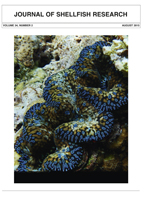The razor clam Ensis macha (Molina, 1782), is an important resource, which has been overfished, and is now starting to be cultivated. As there is no baseline information on parasites of this bivalve, a histopathological assessment of broodstock was undertaken. Sampling of a total of 128 razor clams was carried out in March, May, September, and December of 2014, to analyze the presence and identification of possible parasites. The razor clam tissues were routinely processed for histology, observed under light microscopy, and photographed. The results showed the presence of rickettsiales-like organisms (RLO) in the epithelium of the digestive gland, ciliates, and unidentified coccidia in gills, a meront-like cell in one digestive gland, digenean trematode sporocysts in gonads, metacercariae embedded in the foot, and turbellarians in gills. The prevalence of infection was calculated for each parasite and for each sampling event, and the infection intensity was assessed for the gill coccidian, the RLO, and the hemocytic infiltration foci. The parasites with the highest prevalence were the coccidia with 73% in September. Hemocytic infiltration had a high prevalence in all sampling months, ranging from 78% to 100%.No serious damage was observed in the hosts because of the identified parasites, except for the coccidian, which disrupted part of the interlamellar bridges, and the trematode sporocysts in the gonad of the razor clams, which caused almost complete castration of the gonadal tissue. None of the identified parasites is notifiable to the World Organisation for Animal Health (OIE).
How to translate text using browser tools
1 August 2015
Histopathological Assessment of Broodstock of the Razor Clam Ensis macha (Pharidae) from the Tongoy Bay, Chile
Estefanía Orellana,
Karin B. Lohrmann
ACCESS THE FULL ARTICLE

Journal of Shellfish Research
Vol. 34 • No. 2
August 2015
Vol. 34 • No. 2
August 2015
branchial coccidia
hemocytic infiltration
parasites
razor clam Ensis macha (Pharidae)
rickettsiales-like organisms
trematodes




